|
|
By Holger Schulze, Berlin
The first printed publication of the network is out (in german language): the journal Positionen – Texte zur aktuellen Musik invited us to contribute to their latest exploration of the developments and findings in the field of sound and auditory culture.
Beginning last summer we conceptualized a series of polemics, reviews, overviews, and even a compressed analysis of the state of research in the sound studies. We hope that our editorial cooperation for this issue of the Positionen serves as a good start to promote the exchange between the german and the international discussion – and that it can be helpful for researchers and scholars, students and teachers in the field of auditory research.
Our contributions are:
Holger Schulze, Jens Gerrit Papenburg & Maria Hanáček:
Sound in Media Culture. Porträt eines internationalen Forschungsnetzwerkes
*
Musik Vs. Sound. Fünf Polemiken
1. Maria Hanáček:
Perspektivwechsel
2. Veit Erlmann:
Päng. Ein Interview
3. Holger Schulze:
Zwei Formationen
4. Rolf Großmann:
Schriftlichkeiten
5. Diedrich Diederichsen:
Sound – Musik – Pop – Musik
*
Jens Gerrit Papenburg & Holger Schulze:
Fünf Begriffe des Klangs. Disziplinierungen und Verdichtungen der Sound Studies
Holger Schulze:
»The train is already running« SoundActs: Conference on Sound Studies
By Holger Schulze, Berlin
The third workshop of the research network took place in London, and it was the final and third venue in an art university: the London College of Music. We started on friday with two public lectures on the question of realism in studio production. Simon Zagorski-Thomas presented his notion of sonic cartoon with reference to the use of exaggerating and enhancing effects in the post-production of e.g. Bob Marley & The Wailers’ Lively Up Yourself. Paul Théberge then introduced us to aspects of film sound that stress the tactility, the immersiveness and the hyperrealist or even hallucinatory nature of film sound (with examples from the movies Amadeus, Inception and The last Mimzy.)
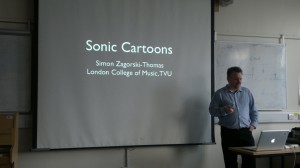 
*
On saturday the closed workshop session took place. Under the basic titel of Sound in Media Culture we did start in the morning with our regular series of 6 brief 10-minute-presentations; the network-members and guests Simon Zagorski-Thomas, Paul Théberge, Franco Fabbri, Maria Hanáček, Golo Föllmer and Carlo Nardi explored the following aspects of mediation and culturality of sound: How can we understand studio production in terms of an enhancing of auditory aspects, cartoon-like? In what way does sound (e.g. in anime-movies) substitute what is not real and present? How do we speak about sound in different native languages? How do narrations about famous studio buildings shape the common notion of the popluar music produced therein? What indicators or dimensions can be found to outline the material and empirical aesthetic of a radio station? How can we construct a theoretical approach to sound that integrates and pays respect to the genuine practical aspects of working with sound as well?
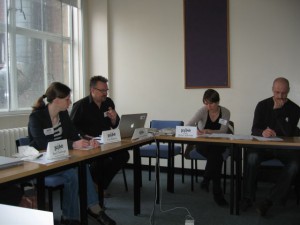 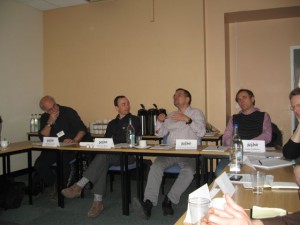
The afternoon was devoted to practical working group sessions in three studios by applying practice-based, artistic as well as design-related methods of research: one group explored the theory and learned also the practical aspects and results of the studio technique of worldizing a recorded sound by playing it back and recording it again in a public, non-studio environment; another group discussed and explored the dialectic between mediation and construction in media artifacts of popular music (as in tracks by Eric Prydz, Massive Attack/Mad Professor et.al.); and a third group explored the benefits and deficiencies of an empirical method to research the individual effects of different vocal styles and the Stimmschlüssel of speakers in different radio stations.
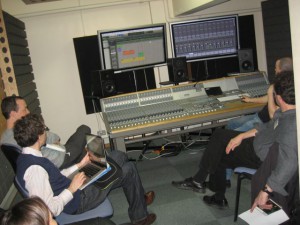 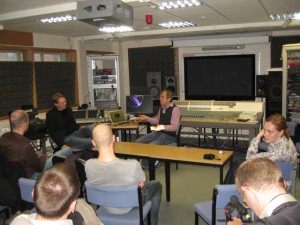 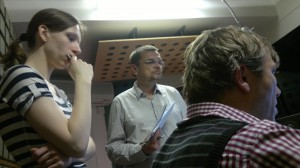
In the final plenary discussion the next steps of our work on the handbook and the production of an accompanying CD were discussed and structured for the remaining three workshops in Berlin, Lüneburg and Torino.
*
On the morning of the last day, sunday, a discussion for the first of a series of three radio features (under the headline of Adventures in Sound: Explorations to Artists, Designers, Musicians & Researchers) was recorded in the rooms of the MA Record Production. Participants were, according to their research focuses, Maria Hanáček, Holger Schulze, Paul Théberge and Simon Zagorski-Thomas as well as our special guest David Toop; Toop brought to our discussion inspiring and provocating new aspects of the limited historical and cultural reach and predominance of the concept of the studio as an important technological dispositive for audio production. The radio feature will be aired in the programme of Deutschlandradio Kultur Berlin on July 8, 2011, starting from 0:05 (Berlin time).
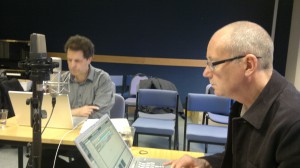 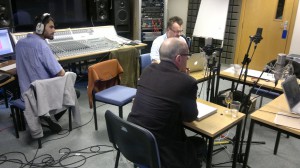
It was also David Toop who pointed us to this incredible track with all what is at stake right now in sound production – concerning non-gestural texture, physical gesture as well as the use of a dynamic time-structure on the one hand and a spatial amalgamation to dismantle a whole genre on the other hand: DJ Rashad & Add-2: Ghetto Tekz Runnin It (Ghettophiles! Chigaco 2011)
By Holger Schulze, Berlin
Realism In Recorded Music And Sound For The Moving Image
A public lecture & discussion
at the London College of Music,
MA Record Production
on the occasion of the 3rd Workshop
of the International Research Network,
funded by the German Research Foundation DFG
Friday March 25, 2011
4pm – 6pm
Thames Valley University
London College of Music
St. Mary’s Road, Ealing, London W5 5RF
Room TC102
Programme:
Paul Théberge:
Sounds, Studios and Screens – Studios as Dreamworlds
The notion of ‘realism’ that pervades cinema aesthetics is an ideology that conceals the fact that the work of the sound studio is not so much a work of mimesis as a work of the imagination. In a sense, while sound engineers work with recorded sounds, they imagine something else and realize those sounds in the studio – the studio is the first place where these sounds are truly heard.
Sound work in the studio operates by means of analogy; its aim is a tactile proximity; editing, enhancement, processing and mixing are its basic techniques; music is ubiquitous, appears to emanate from unseen sources, and inhabits a virtual space of its own.
The sounds become real in relation to images and narration but, ultimately, the combined effect of this process on audiences is as much material as it is meaningful. If cinema is a ‘dreamworld’, then the studio is where the dream begins.
Dr. Paul Théberge of Carleton University, Ottowa is the Canada Research Chair in Technological Mediations of Culture and author of Any Sound You Can Imagine.
Simon Zagorski-Thomas:
Sonic Cartoons
Very little recorded music is realistically staged and we’re all very used to the hyper-real, larger than life sound of contemporary popular music and cinema sound. The staging of recorded music has evolved in conjunction with both musical and technological changes and one of the characteristics of this evolution has been the emergence of techniques that exaggerate particular features.
Just as visual cartoonists will highlight one or two features to represent some complex phenomenon, sonic cartoons do the same. The notion from the 1950s that a good recording should sound as it would in the best seats in a concert hall has been substantially altered by notions of clarity, high fidelity and atmosphere.
Dr. Simon Zagorski-Thomas of the London College of Music, TVU is Chairman of the Association for the Study of the Art of Record Production.
By Holger Schulze, Berlin
The second workshop of the research network took place in Vienna, and it was also the second of three venues in an art university: the Akademie der Bildenden Künste Wien.
On friday it all started with a public symposion on the question: In what way could it be meaningful and fruitful to install a program on Sound Studies at an art university? Jochen Bonz started with a reflection on the function of a decidedly heteronomous subjectivity analyzing the article White Light/White Heat: Jouissance Beyond Gender in the Velvet Underground (1999) by Jeremy Gilbert as well as Acoustic Environments in Change (2009) by Helmi Järviluoma and numerous finnish colleagues, a re-study of the seminal Five Villages-study from 1975 (originally by members of the World Soundscape Project). Holger Schulze then presented the basic concept, the syllabus and the central institutional and team-building approaches of the M.A. in Sound Studies that he and numerous colleagues developed and installed at the Universität der Künste Berlin since the year 2000.

A final panel discussion with personnel and guests from the local institution as well as the sound art-scene such as electronic sound and recording artist Franz Pomassl (co-founder of the Austrian Laton experimental techno label and of the Soundstudio at the Academy of the Fine Arts), TONSPUR-curator Georg Weckwerth and sound artist Christina Nemec (a.k.a. Chra) discussed with Diedrich Diederichsen how it could be inspiring and possible to install a Sound Studies-program at this specific art university?
*
On saturday the closed workshop session took place. Under the titel of Sound in everyday life within popular culture we did start in the morning with a series of 5 very brief (only 10mins!), but provocating presentations and discussions at a roundtable under the title of What kind of Popular can be voiced ; the network-members and guests Thomas Hecken, Diedrich Diederichsen, Carla Müller-Schulzke, Claudia Bullerjahn and Thomas Schopp stirred up truly controversively and lively discussions on the questions: How have notions of the popular been embedded in historically specific discourses? How can a critically informed aesthetic perspective on sound in music and film interrupt received narratives of pop culture? What are the effects of polyphonic listening on received concepts of voice and identity in popular culture? How do the functions of popular music change in relation to the changing formats of production, reception, and dissemination? And finally: If we are losing the popular: What are the consequences of this perspective for the study of sound and music?

In the three separated working groups on the afternoon we discussed specific aspects of popular culture in relation to the Sound Studies and the reference handbook which this research network is working on. The broad plenary discussion on late afternoon showed us how a first complex and disciplinary as well as historically, culturally and methodologically differentiated structure of the handbook could unfold.
At the last day, sunday, as some of us went to the exhibition Hyper Real in the MUMOK we could experience other aspects of popular culture in the fine arts. Or as an artist’s statement in this exhibition said: »I don’t think subject matter should be very important − but it is important.« (unfortunately I do not recall who it was; but if you can help me out, please do so! Thank you.) My personal soundtrack for these days in Vienna was this truly hyperreal-soundproduction by the three Dubstep-heros Benga, Skream and Artwork of Magnetic Man: I Need Air.
By Holger Schulze, Berlin
Sound an der Kunstakademie!?
A public Symposion
at the Academy of Fine Arts Vienna
on the occasion of the 2nd Workshop
of the International Research Network,
funded by the German Research Foundation DFG

Friday November 26, 2010
2pm – 7pm
Academy of Fine Arts Vienna
Schillerplatz 3
A-1010 Vienna
Room M13A
Program (in German):
2:00pm
Opening Words:
Rektor Stefan Schmidt-Wulffen
Holger Schulze (DFG-Network)
2:30pm
Jochen Bonz:
Who’s in charge of sound-perception?
On the subjective nature of Sound Studies’ validity.
3:30pm
Holger Schulze:
Klang studieren?
Sound Studies als Artistic Research.
4:30pm
Coffee break
5:00pm
Wer will was vom Sound
Panel: Christina Nemec, Franz Pomassl, Georg Weckwerth, Moderation: Diedrich Diederichsen
By Holger Schulze, Berlin
One year ago we – Jens Gerrit Papenburg, Maria Hanáček, and me – thought hard about the concept of this network, in the summer of ’09. And now, finally, the first workshop in Berlin really took place and is over. So, now it’s time to ask: What took place?
It all began on friday with a tiny symposion. Michael Bull started with a tour d’horizon on the situation of publishing on sound cultures, handbooks that are on the way and book series as well as peer-reviewed, international journals that could be installed soon; Daisuke Ishida and Marco Montiel-Soto took it away with an audiovisual and a solely acousmatic work: Montiel-Soto’s Maaáwaa: State before disorientation threw us deep in an urban, non-western situation of auditory disorientation – and Ishidas performance Erratic Flow encircled the audience with extreme media-inherent sounds: a kind of transcultural and technological earcleaning. Finally Golo Föllmer, Jochen Bonz and Jens Gerrit Papenburg did wrap it up with three inspiring positions on the voice which raised lots of the questions in the audience how to understand this continuum of mediated and processed voices – especially in popular culture.
*
On saturday the closed workshop session took place: the main format of this network. To work on the planned reference handbook (to be published in 2013/14) we had elaborated a structure to try out on this very first workshop under the titel of New sound concepts and terminological approaches.

We did start in the morning with a series of 5 very brief (only 10mins!), but provocating presentations and discussions at a roundtable under the title of What Sound is not (e.g. Sound is not the Score by Rolf Großmann or Sound is not only a Western Phenomenon by Thomas Burkhalter); followed in early afternoon by three working groups to specific questions arising out of the morning session (e.g. Sound Concept and/or Sound Practice, Sonic Essentialisms & Ontologizations, Separation of Sensory Channels & The Anti-Visual); PhD-researchers Carla Müller-Schulzke, Marta Garcia Quiñones and Thomas Schopp presented their likewise positions in the working groups as starting statements. The day closed on late afternoon and with a broad plenary discussion on the main topics and terminological questions we should deal with in the following – yes – years.
Some of the questions raised in the course of this day and especially in the final round were for instance: What qualitites are attached to related but different terms such as sound, Klang, sonic, audio, auditory, aural or even music? What could be an adequate set of methodologies to do research on sound? What is still needed in terminology and methodology to put the listening and appropriating individuum of sound in the focus? How are the historically separated senses in western culture brought together again through media technology? And how do the senses in the individuum interact and react on each other while performing sensory perception? What aspects of intentionality and non-intentionality of sound are to be researched on? If there is sound in a media culture – how does this change and affect the so-called non-mediated sound (if there is or was any ever)? I personally was surprised and delighted how often the name of Kodwo Eshun and his methodology and theory of sonic fiction was mentioned.
Later that night, Lena won the Eurovision Song Contest – surely nothing else than a phenomenon of Sound in Media Culture. The research network meets again in person in Vienna, at the Akademie der bildenden Künste, where Diedrich Diederichsen will host the second workshop under the title of Sound in everyday life within popular culture, 26th-28th of November 2010.
By Holger Schulze, Berlin
Sound in Media Culture:
Aspects of a Cultural History of Sound
A Sound Studies Symposion
to celebrate the start
of the International Research Network,
funded by the German Research Foundation DFG

Friday May, 28, 2010
4pm – 8pm
Berlin University of the Arts
Central Institute for Continuing Education
Sound Studies – Acoustic Communication
Lietzenburger Straße 45
D-10789 Berlin
Germany
Room 314/315
Program:
4:00pm
Prof. Dr. Martin Supper
(Head of Departement of the
MA Program Sound Studies):
Opening Words
4:30pm
PD Dr. Holger Schulze,
Jens Gerrit Papenburg MA
and Maria Hanáček MA
(Founders of the Research Network):
Introduction to the Research Network
Sound in Media Culture:
Aspects of a Cultural History of Sound
5:00pm
Audio Surprise
with artists from the
Sound Studies MA-program
Marco Montiel-Soto:
Maaáwaa: State before disorientation
Daisuke Ishida:
Erratic Flow
5:30pm
Dr. Michael Bull (University of Sussex):
New Sonic Directions
in Publishing and Research
6:00pm
Panel discussion:
Media and Voices: Radio – Tape – Autotune
With Prof. Dr. Jochen Bonz (Gießen/Bremen),
Jun.-Prof. Dr. Golo Föllmer (Halle),
Jens Gerrit Papenburg MA (Berlin)
6:30pm
Drinks & Drones:
Meet & greet between
Sound Studies students/faculty
and the members/guests of the
international research network
|
|




























